The Intel 6th Gen Skylake Review: Core i7-6700K and i5-6600K Tested
by Ian Cutress on August 5, 2015 8:00 AM ESTGenerational Tests on the i7-6700K: Gaming Benchmarks on Mid-Range GPUs
Alien: Isolation
If first person survival mixed with horror is your sort of thing, then Alien: Isolation, based off of the Alien franchise, should be an interesting title. Developed by The Creative Assembly and released in October 2014, Alien: Isolation has won numerous awards from Game Of The Year to several top 10s/25s and Best Horror titles, ratcheting up over a million sales by February 2015. Alien: Isolation uses a custom built engine which includes dynamic sound effects and should be fully multi-core enabled.
For low end graphics, we test at 720p with Ultra settings, whereas for mid and high range graphics we bump this up to 1080p, taking the average frame rate as our marker with a scripted version of the built-in benchmark.
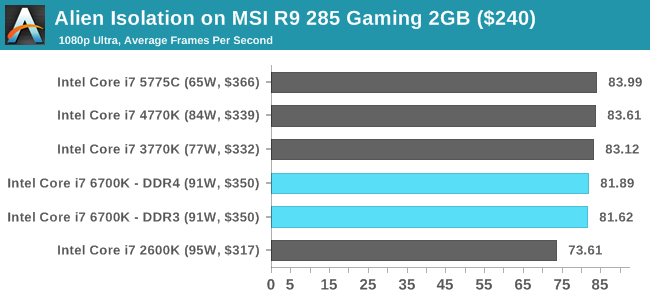
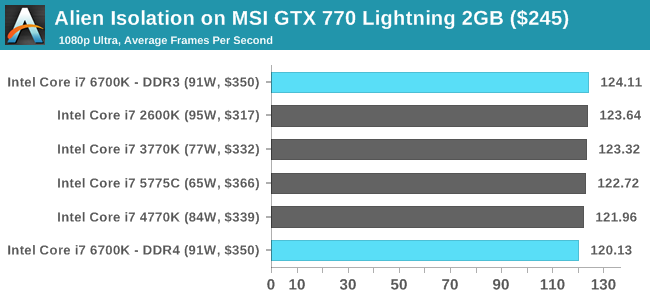
Total War: Attila
The Total War franchise moves on to Attila, another The Creative Assembly development, and is a stand-alone strategy title set in 395AD where the main story line lets the gamer take control of the leader of the Huns in order to conquer parts of the world. Graphically the game can render hundreds/thousands of units on screen at once, all with their individual actions and can put some of the big cards to task.
For low end graphics, we test at 720p with performance settings, recording the average frame rate. With mid and high range graphics, we test at 1080p with the quality setting. In both circumstances, unlimited video memory is enabled and the in-game scripted benchmark is used.
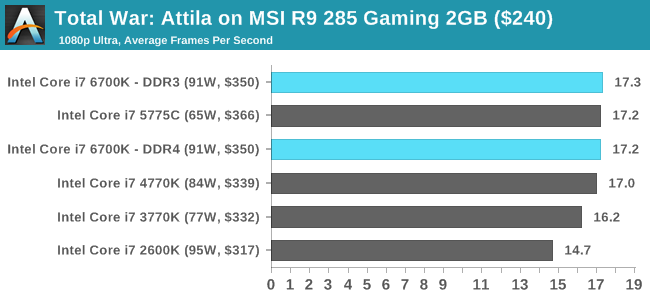
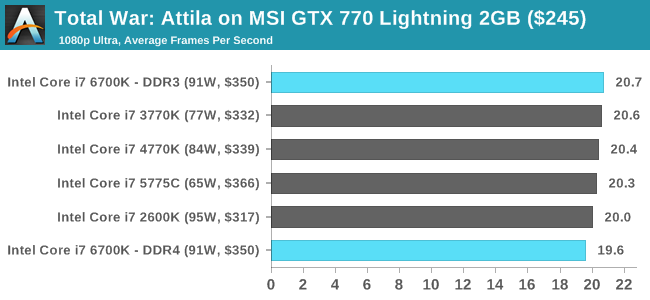
Grand Theft Auto V
The highly anticipated iteration of the Grand Theft Auto franchise finally hit the shelves on April 14th 2015, with both AMD and NVIDIA in tow to help optimize the title. GTA doesn’t provide graphical presets, but opens up the options to users and extends the boundaries by pushing even the hardest systems to the limit using Rockstar’s Advanced Game Engine. Whether the user is flying high in the mountains with long draw distances or dealing with assorted trash in the city, when cranked up to maximum it creates stunning visuals but hard work for both the CPU and the GPU.
For our test we have scripted a version of the in-game benchmark, relying only on the final part which combines a flight scene along with an in-city drive-by followed by a tanker explosion. For low end systems we test at 720p on the lowest settings, whereas mid and high end graphics play at 1080p with very high settings across the board. We record both the average frame rate and the percentage of frames under 60 FPS (16.6ms).
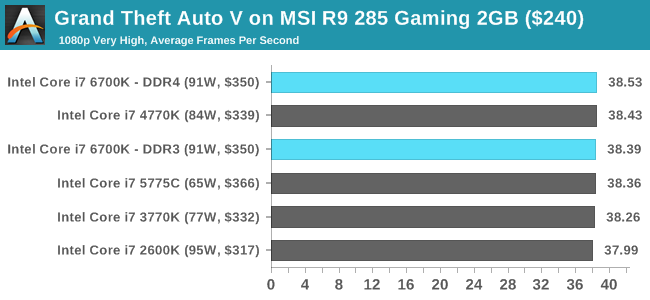
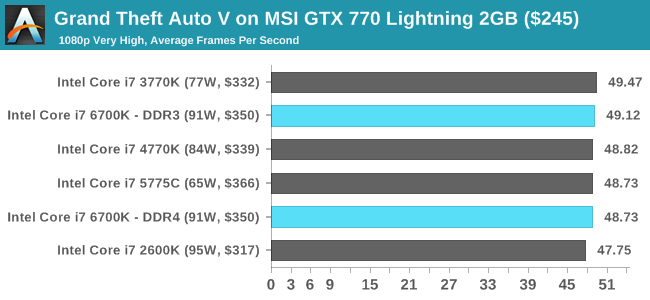
GRID: Autosport
No graphics tests are complete without some input from Codemasters and the EGO engine, which means for this round of testing we point towards GRID: Autosport, the next iteration in the GRID and racing genre. As with our previous racing testing, each update to the engine aims to add in effects, reflections, detail and realism, with Codemasters making ‘authenticity’ a main focal point for this version.
GRID’s benchmark mode is very flexible, and as a result we created a test race using a shortened version of the Red Bull Ring with twelve cars doing two laps. The car is focus starts last and is quite fast, but usually finishes second or third. For low end graphics we test at 1080p medium settings, whereas mid and high end graphics get the full 1080p maximum. Both the average and minimum frame rates are recorded.
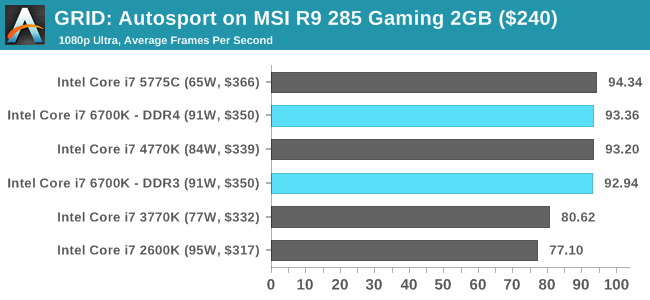
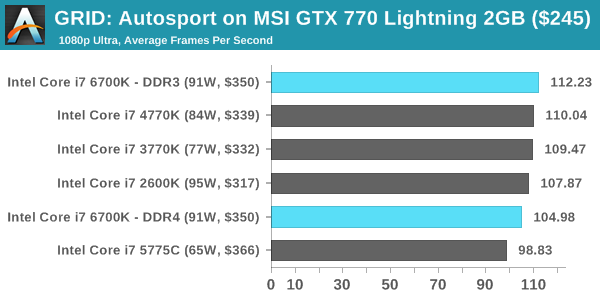
Middle-Earth: Shadow of Mordor
The final title in our testing is another battle of system performance with the open world action-adventure title, Shadow of Mordor. Produced by Monolith using the LithTech Jupiter EX engine and numerous detail add-ons, SoM goes for detail and complexity to a large extent, despite having to be cut down from the original plans. The main story itself was written by the same writer as Red Dead Redemption, and it received Zero Punctuation’s Game of The Year in 2014.
For testing purposes, SoM gives a dynamic screen resolution setting, allowing us to render at high resolutions that are then scaled down to the monitor. As a result, we get several tests using the in-game benchmark. For low end graphics we examine at 720p with low settings, whereas mid and high end graphics get 1080p Ultra. The top graphics test is also redone at 3840x2160, also with Ultra settings, and we also test two cards at 4K where possible.
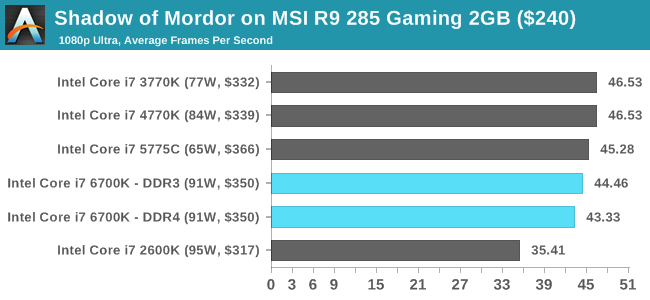
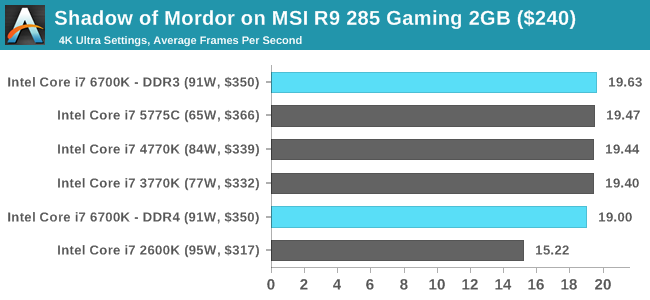

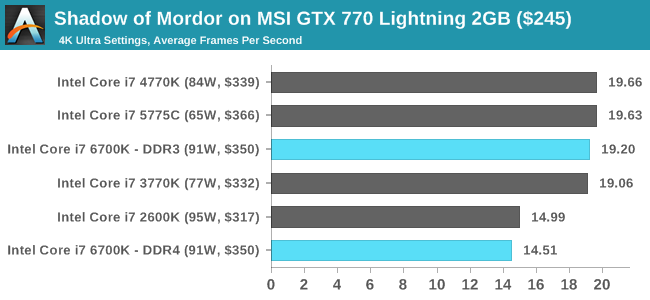















477 Comments
View All Comments
MrSpadge - Friday, August 7, 2015 - link
It works, of course, and is OK for bursty load (like any regular desktop system sees). I'm interested in energy efficeint 24/7 load, however, that's why I said specifically "more than I would give...".royalcrown - Wednesday, August 5, 2015 - link
How much for that sweet board on page 2 of the article ? Please paint in 4 more ram slots, I'll be mailing in a check today. Also, please paint me a 6 ghz processor with 30% OC to go with it and I'll mail another check !DanNeely - Wednesday, August 5, 2015 - link
"Here’s a suggestion: bring back the old turbo button on a chassis. When we saw 66 MHz become 75 MHz, it was the start of something magical. If Intel wants to grow overclocking, that’s a fun place to start."*BAH*
The turbo button turned my 486 into an 8086 so I could run old games; pushing it certainly didn't give an OC.
Teknobug - Wednesday, August 5, 2015 - link
Don't forget the math co-processorDanNeely - Wednesday, August 5, 2015 - link
I had a 486SX, so no hardware FPU in either state.royalcrown - Saturday, August 8, 2015 - link
Yeah, 80387 FTW !!ant6n - Wednesday, August 5, 2015 - link
I remember hitting that button accidentally on my 33Mhz 386 (it had no MHz display). It took me a couple of days to figure out why the fuck the computer was so slow all of the sudden.zShowtimez - Wednesday, August 5, 2015 - link
So here I am, still going to stick with my 4.8Ghz i7 Sandy Bridge.Just going to replace my SLI GTX 670s next year when Pascal comes out...
I can't rationalize upgrading the CPU when all I use it for is gaming.
postem - Wednesday, August 5, 2015 - link
See my other comment. When i switched to 4790K from 950, i through it would be minimal; in some scenarios, yes, but on vastly everything else, its paying off. Comming from 950 @ 4.2 ghz i saw around 20-30% frame increase, in some heavy titles like total war even more.eek2121 - Wednesday, August 5, 2015 - link
Yes, but you have to realize that the 4790k is not that much faster than the 2600k. Definitely not worth replacing all the components. The 2600 was significantly faster than your 950.